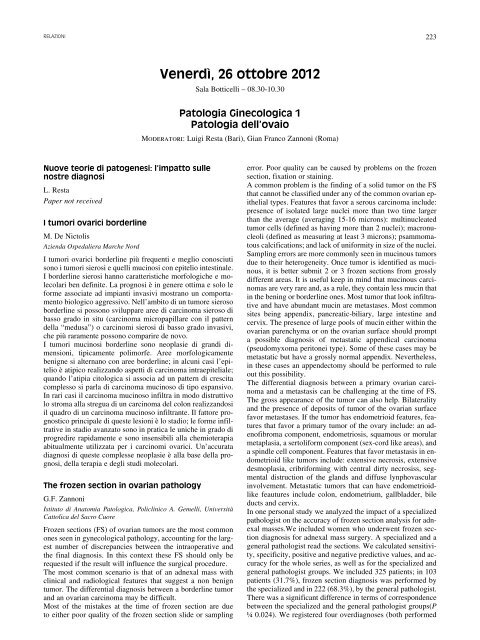Sabato 27 ottobre 2012 - Pacini Editore
Sabato 27 ottobre 2012 - Pacini Editore
Sabato 27 ottobre 2012 - Pacini Editore
Create successful ePaper yourself
Turn your PDF publications into a flip-book with our unique Google optimized e-Paper software.
RElaziONi<br />
nuove teorie di patogenesi: l’impatto sulle<br />
nostre diagnosi<br />
L. Resta<br />
Paper not received<br />
I tumori ovarici borderline<br />
M. De Nictolis<br />
Azienda Ospedaliera Marche Nord<br />
I tumori ovarici borderline più frequenti e meglio conosciuti<br />
sono i tumori sierosi e quelli mucinosi con epitelio intestinale.<br />
I borderline sierosi hanno caratteristiche morfologiche e molecolari<br />
ben definite. La prognosi è in genere ottima e solo le<br />
forme associate ad impianti invasivi mostrano un comportamento<br />
biologico aggressivo. Nell’ambito di un tumore sieroso<br />
borderline si possono sviluppare aree di carcinoma sieroso di<br />
basso grado in situ (carcinoma micropapillare con il pattern<br />
della “medusa”) o carcinomi sierosi di basso grado invasivi,<br />
che più raramente possono comparire de novo.<br />
I tumori mucinosi borderline sono neoplasie di grandi dimensioni,<br />
tipicamente polimorfe. Aree morfologicamente<br />
benigne si alternano con aree borderline; in alcuni casi l’epitelio<br />
è atipico realizzando aspetti di carcinoma intraepiteliale;<br />
quando l’atipia citologica si associa ad un pattern di crescita<br />
complesso si parla di carcinoma mucinoso di tipo espansivo.<br />
In rari casi il carcinoma mucinoso infiltra in modo distruttivo<br />
lo stroma alla stregua di un carcinoma del colon realizzandosi<br />
il quadro di un carcinoma mucinoso infiltrante. Il fattore prognostico<br />
principale di queste lesioni è lo stadio; le forme infiltrative<br />
in stadio avanzato sono in pratica le uniche in grado di<br />
progredire rapidamente e sono insensibili alla chemioterapia<br />
abitualmente utilizzata per i carcinomi ovarici. Un’accurata<br />
diagnosi di queste complesse neoplasie è alla base della prognosi,<br />
della terapia e degli studi molecolari.<br />
The frozen section in ovarian pathology<br />
G.F. Zannoni<br />
Istituto di Anatomia Patologica, Policlinico A. Gemelli, Università<br />
Cattolica del Sacro Cuore<br />
Frozen sections (FS) of ovarian tumors are the most common<br />
ones seen in gynecological pathology, accounting for the largest<br />
number of discrepancies between the intraoperative and<br />
the final diagnosis. In this context these FS should only be<br />
requested if the result will influence the surgical procedure.<br />
The most common scenario is that of an adnexal mass with<br />
clinical and radiological features that suggest a non benign<br />
tumor. The differential diagnosis between a borderline tumor<br />
and an ovarian carcinoma may be difficult.<br />
Most of the mistakes at the time of frozen section are due<br />
to either poor quality of the frozen section slide or sampling<br />
Venerdì, 26 <strong>ottobre</strong> <strong>2012</strong><br />
Sala Botticelli – 08.30-10.30<br />
Patologia Ginecologica 1<br />
Patologia dell’ovaio<br />
Moderatori: Luigi Resta (Bari), Gian Franco Zannoni (Roma)<br />
223<br />
error. Poor quality can be caused by problems on the frozen<br />
section, fixation or staining.<br />
A common problem is the finding of a solid tumor on the FS<br />
that cannot be classified under any of the common ovarian epithelial<br />
types. Features that favor a serous carcinoma include:<br />
presence of isolated large nuclei more than two time larger<br />
than the average (averaging 15-16 microns): multinucleated<br />
tumor cells (defined as having more than 2 nuclei); macronucleoli<br />
(defined as measuring at least 3 microns); psammomatous<br />
calcifications; and lack of uniformity in size of the nuclei.<br />
Sampling errors are more commonly seen in mucinous tumors<br />
due to their heterogeneity. Once tumor is identified as mucinous,<br />
it is better submit 2 or 3 frozen sections from grossly<br />
different areas. It is useful keep in mind that mucinous carcinomas<br />
are very rare and, as a rule, they contain less mucin that<br />
in the bening or borderline ones. Most tumor that look infiltrative<br />
and have abundant mucin are metastases. Most common<br />
sites being appendix, pancreatic-biliary, large intestine and<br />
cervix. The presence of large pools of mucin either within the<br />
ovarian parenchyma or on the ovarian surface should prompt<br />
a possible diagnosis of metastatic appendical carcinoma<br />
(pseudomyxoma peritonei type). Some of these cases may be<br />
metastatic but have a grossly normal appendix. Nevertheless,<br />
in these cases an appendectomy should be performed to rule<br />
out this possibility.<br />
The differential diagnosis between a primary ovarian carcinoma<br />
and a metastasis can be challenging at the time of FS.<br />
The gross appearance of the tumor can also help. Bilaterality<br />
and the presence of deposits of tumor of the ovarian surface<br />
favor metastases. If the tumor has endometrioid features, features<br />
that favor a primary tumor of the ovary include: an adenofibroma<br />
component, endometriosis, squamous or morular<br />
metaplasia, a sertoliform component (sex-cord like areas), and<br />
a spindle cell component. Features that favor metastasis in endometrioid<br />
like tumors include: extensive necrosis, extensive<br />
desmoplasia, cribriforming with central dirty necrosiss, segmental<br />
distruction of the glands and diffuse lynphovascular<br />
involvement. Metastatic tumors that can have endometrioidlike<br />
feautures include colon, endometrium, gallbladder, bile<br />
ducts and cervix.<br />
In one personal study we analyzed the impact of a specialized<br />
pathologist on the accuracy of frozen section analysis for adnexal<br />
masses.We included women who underwent frozen section<br />
diagnosis for adnexal mass surgery. A specialized and a<br />
general pathologist read the sections. We calculated sensitivity,<br />
specificity, positive and negative predictive values, and accuracy<br />
for the whole series, as well as for the specialized and<br />
general pathologist groups. We included 325 patients; in 103<br />
patients (31.7%), frozen section diagnosis was performed by<br />
the specialized and in 222 (68.3%), by the general pathologist.<br />
There was a significant difference in terms of correspondence<br />
between the specialized and the general pathologist groups(P<br />
¼ 0.024). We registered four overdiagnoses (both performed







